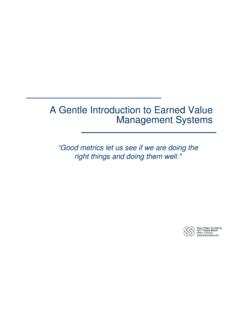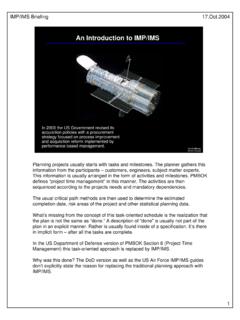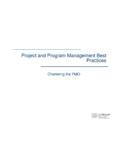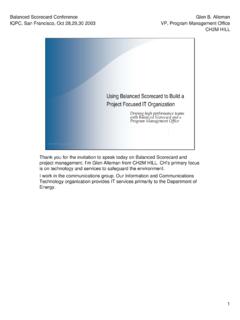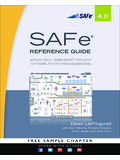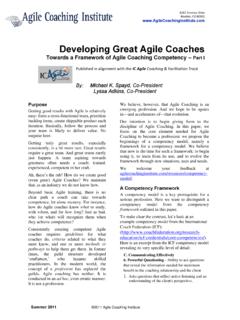Transcription of Agile Estimating and Planning - Niwot Ridge
1 Page 1 of 14 Agile Estimating and Planning , Mike Cohn, Prentice Hall I ve been meaning to buy this book since its release, but Mike was kind enough to send me one for review. I ve come to this book from a two year Planning assignment on two large aerospace programs and prior experience as a Program Management Officer for the IT portion of a very large Department of Energy program. But these jobs are not my normal profession, which is Enterprise IT management and product development. I was pulled into these Planning roles through proposal efforts that won and I was left to implement the plan. Be careful for what you wish. How Planning is done for spacecraft and construction is similar to what Mike describes in this book.
2 Because of this background and the 6 or so years experience in managing Agile software development projects, my approach to this review is to read the book through my own experience rather than assess the book as a standalone process. I ve assumed all the content is well developed and vetted. What I ll try to assess is how to apply the book outside the converted that is, how to put the book to work in domains outside Agile software development. First let me state my point of view. Working on DoD, NASA and DOE projects, I ve been converted to the Systems Engineering paradigm. Systems Engineers see the world in an integrated manner product development and process development are inseparable.
3 Managing interfaces is the primary role of Systems Engineering along with product and process architecture. Yes, processes have architecture as well. Planning lives inside process architecture. Good Planning is a systems engineering activity. The plan represents the processes that build the product and the architecture and technology of the product impacts how the plans are developed driving the programmatic architecture. Planning and building are inseparable. Mike s book makes this clear in the same way a good systems engineering process does. Quick Look Buy this book, it s useful and informative. It contains a few of my hot button errors, but that s to be expected since the Agile processes, including Estimating and Planning are not derived from the high ceremony Planning world.
4 Mike stays pretty much on a mainstream message when describing the activities involved in Planning and Estimating . No weird units of measure, no unsubstantiated claims of miraculous tools and processes, no divergent philosophical excursions. Just plain, understandable suggestions, on how to approach what is a difficult and sometimes intractable problem how much does this cost, when will it be done, where are the risks, what are we doing about them, and what do I get when we re done? Summary The concept of Agile Planning can go to one of two extremes the Planning of Agile projects or Agile Planning of projects. Mike has straddled the middle, suggesting that the book is about the Planning of Agile projects, but he includes materials that can be used for general purpose Planning of any project.
5 He lays out a logical process of partitioning the Planning around the granularity of the plan, focusing on the daily, iteration and release Planning processes. Leaving the product, portfolio and strategy Planning for others. This Page 2 of 14 is important since those Planning processes must be in place in order to provide a framework for the lower level Planning activities. My Planning experience is built around the IMP/IMS (Integrated Master Plan / Integrated Master Schedule) approach (and its derivatives) as described in the Department of Defense guide. After reading Mike s book I was stuck by the similarity between the Agile Planning processes and IMP/IMS.
6 Event based Planning is core to IMP/IMS. The plan describes the effort necessary to deliver the increasing maturity of the program through assessable and verifiable accomplishments. These accomplishments describe progress rather than the passage of time. Mike s approach provides measurable assessment of progress through conditions of satisfaction. The fine grained iteration based delivery process measures progress through the production of working products (features or capabilities). In IMP/IMS, the granularity may be larger only because the programs may be larger but the principle is nearly the same progress is measured through significant accomplishments and the exit criteria used to verify their completion.
7 The maturity of the program is measured by these significant accomplishments, NOT the simple passage of time. The other principles described in the book can be found in good project management guides as well. (There are many guides beyond PMI s PMBOK) Here are some references that provide this background. Maybe of these guides are targeted at large and complex projects, but many of Mike s processes are directly applicable to a broad range of projects sizes and complexities. This is the power of the book. It is not just a book about Planning small Agile software development projects. Other project domains will find many useful ideas as well. My Biased Approach to Book Reviews My approach to a book review is to read the chapters in sequential order, making notes as I go.
8 I then use these notes to comment on the chapters and write a summary recommendation at the end. Before starting the reading the chapters, I look through the bibliography to find papers or books that I have not come across before. Mike has done a good job of providing sources and other materials to augment the book. There are some references I had not seen before, so the bibliography alone added value. Mike has both sides covered good original ideas and the references to back them up especially on the Estimating process side. Next, I look at the art work to see if the pictures are notional 1 or substantive in nature. For the most part they are notional, but this is probably the best that could be done for the audience.
9 I ve assumed the substance of the book is valid, and I m commenting on how I would use this content in my work. 1 The idea of a notional description is powerful but it has limits if not bounded. These unbounded descriptions are very common in the Agile literature. The exuberance of using the notional description as the executable description is common. The problem of course is the three infamous words this doesn t scale come into play. Especially once a non-trivial Planning and Estimating project comes along. Page 3 of 14 Chapter 1 The Purpose of Planning Figure is the standard diagram for technical performance measures, 2 increasing maturity of IMP/IMS, or reducing performance variance for every product and process we use on our program.
10 Changing the horizontal axis to the appropriate names allows the diagram to be the basis of every Planning process. The only issue is that the variance at the end point is never 0, it always has some uncertainty. Here in aerospace we call such a diagram notional, meaning it is a good representation of what the solution will look like, but is not actually correct in practice. The other thing notional with the figure (and therefore wrong) is the variances are never symmetrical in practice. When I see symmetrical variance it tells me the picture does not represent any real process. The PMI approach to the Estimating problem is na ve to start with and simply wrong in the end.
